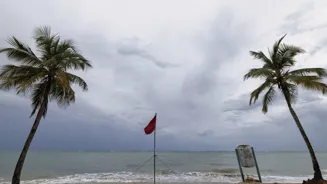What is the story about?
A stronger and larger Hurricane Erin battered sections of the Caribbean and was expected to cause severe surf and rip currents along the United States East Coast this week.
According to the US National
Hurricane Center in Miami, it intensified to a Category 4 storm with maximum sustained winds of 130 mph (215 kph) early Monday when its outer bands began to hit the southeast Bahamas and the Turks and Caicos Islands.
Around 2 a.m. Monday, Erin was approximately 110 miles (175 kilometres) northeast of Grand Turk Island and 935 miles (1,500 kilometres) south-southeast of Cape Hatteras, North Carolina. The storm was moving northwest at 12 mph (19 km/h).
Erin was predicted to remain a huge, major storm
throughout midweek, with more intensification predicted for Monday and then slow fading.
Hurricane-force winds stretched up to 60 miles (95 km) from the centre, while tropical-storm winds extended up to 230 miles (370 kilometres). The region of severe winds is projected to expand further during the following few days. Even though Erin is not expected to make a direct landfall, its enormity will have an impact on coastal communities.
Dare County, North Carolina, declared an emergency and ordered Hatteras
Island in the Outer Banks, a small band of low-lying barrier islands jutting out into the Atlantic, to be evacuated beginning Monday. Several days of heavy surf and high winds and waves could wash out parts of N.C. Highway 12 running along the barrier islands, the National Weather Service said.
Erin, the year's first Atlantic hurricane, reached an exceedingly dangerous Category 5 status Saturday with 160 mph (260 kph) winds before weakening.
"You're dealing with a major hurricane. The intensity is
fluctuating. It's a dangerous hurricane in any event," Richard Pasch of the National Hurricane Center said.
Erin's outer bands pelted parts of Puerto Rico and the Virgin Islands with heavy rains and tropical-storm winds during the day Sunday.
That knocked out power to about 147,000 customers, according to Luma Energy, a private company that oversees the transmission and distribution of power on the island. More than 20 flights were canceled due to the weather. The Coast Guard allowed all ports in Puerto Rico and the US Virgin Islands to reopen
Sunday as winds and rains decreased.
Rough ocean conditions were forecast for parts of the Virgin Islands, Puerto Rico, Hispaniola and the Turks and Caicos. Life-threatening surf and rip currents were forecast into midweek for the Bahamas, Bermuda, the US East Coast and Canada's Atlantic coast as Erin turns north and then northeast.
Scientists have linked the rapid intensification of hurricanes in the Atlantic to climate change. Global warming is causing the atmosphere to hold more water vapor and is spiking ocean
temperatures, and warmer waters give hurricanes fuel to unleash more rain and strengthen more quickly.
According to the US National
Around 2 a.m. Monday, Erin was approximately 110 miles (175 kilometres) northeast of Grand Turk Island and 935 miles (1,500 kilometres) south-southeast of Cape Hatteras, North Carolina. The storm was moving northwest at 12 mph (19 km/h).
Erin was predicted to remain a huge, major storm
Hurricane-force winds stretched up to 60 miles (95 km) from the centre, while tropical-storm winds extended up to 230 miles (370 kilometres). The region of severe winds is projected to expand further during the following few days. Even though Erin is not expected to make a direct landfall, its enormity will have an impact on coastal communities.
Dare County, North Carolina, declared an emergency and ordered Hatteras
Erin, the year's first Atlantic hurricane, reached an exceedingly dangerous Category 5 status Saturday with 160 mph (260 kph) winds before weakening.
"You're dealing with a major hurricane. The intensity is
Erin's outer bands pelted parts of Puerto Rico and the Virgin Islands with heavy rains and tropical-storm winds during the day Sunday.
That knocked out power to about 147,000 customers, according to Luma Energy, a private company that oversees the transmission and distribution of power on the island. More than 20 flights were canceled due to the weather. The Coast Guard allowed all ports in Puerto Rico and the US Virgin Islands to reopen
Rough ocean conditions were forecast for parts of the Virgin Islands, Puerto Rico, Hispaniola and the Turks and Caicos. Life-threatening surf and rip currents were forecast into midweek for the Bahamas, Bermuda, the US East Coast and Canada's Atlantic coast as Erin turns north and then northeast.
Scientists have linked the rapid intensification of hurricanes in the Atlantic to climate change. Global warming is causing the atmosphere to hold more water vapor and is spiking ocean
Do you find this article useful?


















